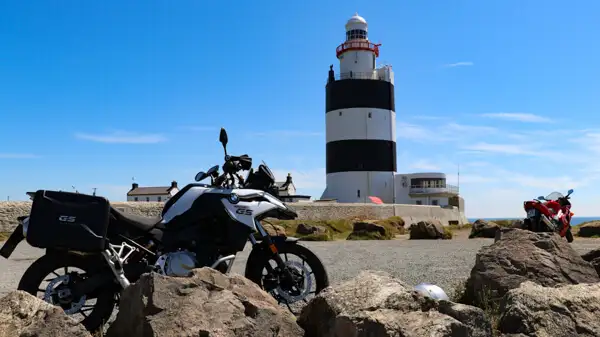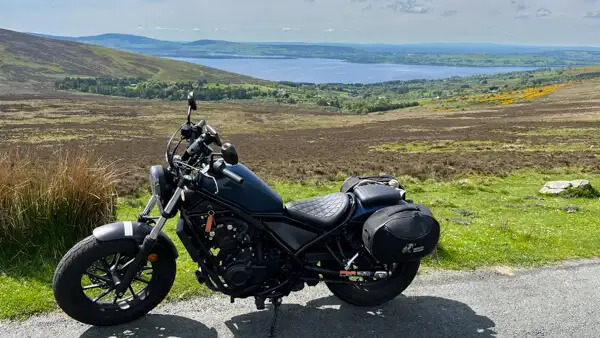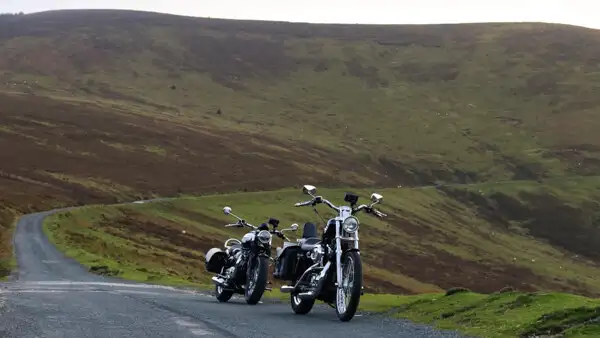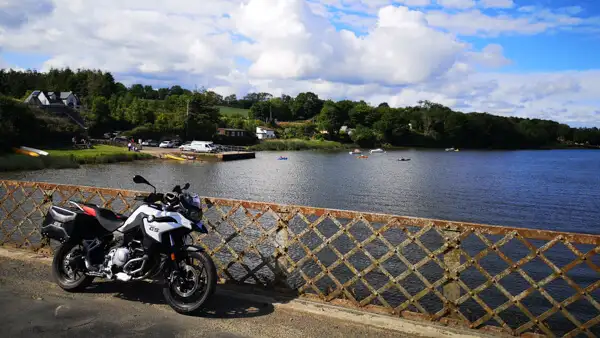Ireland’s east and southeast are overlooked by many travellers, because most continue directly to the west coast.
But the southeast in particular has a lot to offer: From Dublin you can reach many beautiful destinations as a day trip.
Page Contents (click line to jump the text)

Intro
The Ancient East offers many historical sights for the culturally interested. There are many pretty towns, castles and fortresses, monasteries, mansions and parks and also some Celtic cultural sites to admire.
Motorcyclists will find beautiful coastal roads with miles of sandy beaches, rocky coasts and lots of winding hill country. Especially at weekends, many motorcyclists flock to the picturesque Wicklow Mountains National Park.
Ireland’s southeast is my home territory, where we have our motorbike rental (update: had…) and where I ride a lot myself.
Below you will find my personal motorbike highlights in Ireland’s southeast and south:
The Wicklow Mountains National Park
The Wicklow Mountains lie directly south of Dublin and are therefore the home territory of Dublin’s motorcyclists, who are out and about here mainly at weekends. But don’t worry, there aren’t that many of them and they are well distributed in the mountains.
The Irish know where it’s beautiful – the high moorland mountains are wonderful! You can’t go wrong here, it’s beautiful everywhere. A few more route tips follow.
Powerscourt Estate and Powerscourt Waterfall
This magnificent estate is situated on the northern edge of the Wicklow Mountains, close to Dublin. It is a large mansion or castle with several very beautiful gardens and parks. The waterfall is just outside the estate in a clearing – a beautiful place for a picnic!
From Dublin via Sally Gap to Laragh
The R115 starts in south Dublin and loops and turns up the mountains, via Glencree to Sally Gap. Sally Gap is a pass and crossroads that can probably be described as the hub of the Wicklow region.
In Glencree, by the way, there is a German military cemetery – who would have expected it here?
From Blessington via Sally Gap to Lough Tay
The Blessington Lakes and Blessington are a beautiful region for excursions of all kinds. From there the R759 stretches via Sally Gap to Lough Tay. The small road winds wonderfully along the mountainside and reveals beautiful views of the lake. The road continues to Roundwood.

From Hollywood over the Wicklow Pass to Laragh
South of Blessington is the small town of Hollywood. From there you can follow the R756 over the Wicklow Pass to Laragh.
On the way you will see strange stone dumps – these are the remains of old tin and lead mines, of which there were many in this area. Just before Laragh you will see a narrow round tower on your right – this is Glendalough Monastery.
Glendalough Monastery
A monastery was founded here in the early Middle Ages, which in its heyday educated noble sons from all over Europe in theology – it was a medieval university, so to speak.
Glendalough means Valley of the Two Lakes and it is a magically beautiful place framed by steep mountainsides. From the monastery you can reach the first of the two lakes in a few minutes.
From Laragh to Avoca
If you follow the R755 to Rathdrum and then the R752 to Avoca, you will drive beautiful winding roads through the forest and along the river.
Avoca Woollen Mills
The local farmers used to meet here to wash and process their sheep’s wool. At this place two sisters founded a small wool mill, where the wool was spun and woven.
You can visit the nice little wool mill and in the shop next door there are all kinds of wool articles and a small café forhttps://www.easycruiser.tours the lunch break.
Kilkenny and Kilkenny Castle
A little further inland is the town of Kilkenny. It has a very nice old town and a beautiful castle perched high above the river. The castle grounds are freely accessible.
You can also visit the castle from the inside, which takes about 1.5 hours and is really nice. By the way, the beer brand “Kilkenny” comes from here. You can visit the Smithwicks brewery. You can’t buy “Kilkenny” in Irish pubs though, it’s an export brand.
Cashel Rock
The Rock of Cashel rises as a steep rock above the flat surrounding countryside. It is a mixture of castle ruins and cathedral. The kings of Munster once resided here – and later the bishops. Today, Cashel Rock is one of the most important historical sites in Ireland.
Cahir Castle
My personal favourite is Cahir Castle. The Norman fortress is still very well preserved and is beautifully situated by the river.
You can walk around it or visit it. It was besieged many times, so you learn a lot about the rough Middle Ages on the guided tour. There’s a good café-restaurant right next door, and in front of the castle – get this – there’s free motorbike parking!
The Blackstairs Mountains
This ridge is the extension of the Wicklow Mountains almost to New Ross. The highest point is Mount Leinster, the highest mountain in the Leinster region, i.e. the south-east.
On its slope is a beautiful viewpoint, “Nine Stones”. You can follow the ridge on both sides to New Ross.

From Bunclody to Mount Leinster
In Bunclody, take Barker`s Road and follow the signs to Mount Leinster. There you will reach the Nine Stones Viewpoint with beautiful views of the surrounding countryside. From Mount Leinster you can probably see all the way to Wales on a clear day.
From Mount Leinster to Kiltealy
On the other side you go down the mountain again. At the Huntington junction, keep left and follow the hillside until you reach Kiltealy. You are now on the smallest roads in the hinterland.
From Kiltealy to New Ross
You can follow the ridge of the Blackstairs Mountains on both sides to New Ross and both sides are nice to ride. Either take the R731 via Rathnure, or the R729 via Ballymurphy.
Along the River Barrow from Leighlinbridge via Borris to New Ross.
Another nice option is to follow the River Barrow (as far as possible). You go from Leiglinbridge, via Borris and Graignamanagh and on via St Mullins to New Ross.
New Ross
This small harbour town is quite nice for a break. The highlight here is the Dunbrody, a three-masted wooden ship that serves as a museum ship.
Here you can learn all about the many Irish who emigrated to America in the mid-19th century – on ships like this one. The short guided tour of the ship is not only interesting, but also really entertaining.
Waterford
Waterford was founded by the Vikings in the early Middle Ages. After initial depredations, they had settled and important trading posts developed at their ports.
The people of Waterford are proud of their Wilking past. In the “Viking Triangle” at the harbour there are several museums and exhibitions on the subject.
The Sunny South East Coast
The Sunny South East stretches along the coast from the south of Dublin almost to Cork. This is statistically the warmest region in Ireland with the least rainfall.
Today, however, the Sunny South East Coast is usually referred to as the coast as far as Wexford. You will find over 70km of fine sandy beaches here. This is a recreation area and holiday region for many Dublin families.
From Bray to Gorey
Bray is a special harbour town with a beautiful long promenade along the sea. In the summer there is a famous air show here and many smaller festivities. There is also a large seawater aquarium here.
Greystones is also a nice place with a nice harbour and some promenade.
If you follow the coast further, there are always beach accesses, especially at Brittas Bay. Unfortunately, you have to pay to park there most of the time. But you can also just follow the small coastal road and enjoy the views of the sea. The route continues via Arklow to Gorey.
From Gorey to Wexford
Gorey is not directly on the sea, but the small holiday resort of Courtown has a nice little harbour.
From here to Wexford, there are many beautiful beaches with sand dunes that you can visit. The most beautiful are probably Old Bawn Beach, Morriscastle Beach and Curracloe Beach.

Wexford
Wexford was also founded by the Vikings. In the early Middle Ages, it was probably called Waesfjord in Old Norwegian, which roughly means sandy bay. Here the shallow Viking boats could land safely. You can park at the harbour and take a stroll through the pedestrian zone of the old town above the harbour.
Kilmore Quay
South of Wexford on the coast is the pretty fishing village of Kilmore Quay. There are many reed-roofed houses here, a harbour and some good fish restaurants.
Hook Peninsula and Hook Lighthouse
The Hook Peninsula is really beautiful to drive. At its end is a beautiful lighthouse on the rocky cliffs, Hook Lighthouse. The coastline is magnificent and so are the views across the bay towards Waterford.
Passage East
At Passage East you can take a small ferry across the river. The journey only takes a few minutes and is much more fun than taking the bridge further upstream.
Tramore
The resort of Tramore has a nice promenade with a beach and some restaurants. In summer there is a big funfair here and lots of hustle and bustle.
The Copper Coast from Annestown to Bunmahon
You should definitely include this stretch of coast in your tour! High cliffs and rocky bays with small winding roads – a must for motorcyclists. There are also the remains of old copper mines – hence the name Copper Coast.
From Bunmahon to Dungarvan
Bunmahon is a small town by the sea. Dungarvan is a bit bigger and has a nice old harbour with a small old town and restaurants right on the water – very nice!
Youghal
Do you know the old Mobby Dick movie with Gregory Peck from 1956? It was filmed here! There is still a small exhibition about it and a tin whale in the harbour basin.
Blarney Castle
Blarney is located northwest of Cork. There you can visit Blarney Castle. It is actually a large ruin, but very beautifully embedded in a large park. There is also a small castle on the grounds and a rose garden.
Kinsale
This is the start – or end – of the Wild Atlantic Way, which stretches 2500km along the west coast to the northern tip of Ireland. Kinsale is quite nice, but bustling. Above it is Charles Fort with a great view of the wide bay.

To Galley Head Lighthouse
Further on, the National Road N71 leads southwest, but not along the coast. However, you can always make a detour to the sea, for example to Galley Head Lighthouse.
Rosscarbery Bay
It’s not worth rushing past the coast, as it has many nice little towns and beautiful rocky coves to offer Rosscarbery Bay is a good example.
The Drombeg Stone Circle
A little further on follow the signs to the Drombeg Stone Circle. It is a very beautiful Celtic stone circle situated on a hill overlooking the sea.
Via Glandore to Castletownshend
The small harbour village of Glandore nestles against the rock like a swallow’s nest – very pretty! Castletownshend Bay is also lovely to explore.
Baltimore
We can now argue about whether we are still in the south or already in the west – it doesn’t matter! Baltimore used to be a small idyllic fishing port at the end of a long rugged bay with an offshore island.
Today it is more touristy, but the location is still idyllic, especially at the Baltimore Beacon, which marks the entrance to the bay.
Conclusion
The Wild Atlantic Way is certainly the most spectacular route you can drive in Ireland. But also off the Wild Atlantic Way, Ireland offers many possibilities for a nice motorbike holiday.
In Ireland’s south-east and south it is statistically the driest and warmest in Ireland – a good argument for motorcyclists.
The coasts may not be as spectacular as on the WAW, but they are also nice to ride.
And there are many nice places to visit, so that all those who not only want to ride, but also want to see something, will get their money’s worth.
You can follow my tips or just follow your nose – wherever you go – I wish you a nice trip. And if you still need a rental motorbike, you can find us here: www.easycruiser.tours.
More interesting articles for you
THE BEST MOTORBIKE HIGHLIGHTS IN IRELAND’S NORTH
PREPARING FOR A MOTORBIKE TRIP IN IRELAND – ROUTE CHOICE AND NAVIGATION
IRELAND MOTORBIKE TOUR – 11 PARTICULARLY PRETTY IRELAND TOWNS TO STROLL, STOP AND STAY IN
THE BEST MOTORBIKE HIGHLIGHTS IN IRELAND’S WEST
Photo credits cover photo: Ulrich Knüppel-Gertberg (www.irland-insider.de, www.ireland-insider.com)